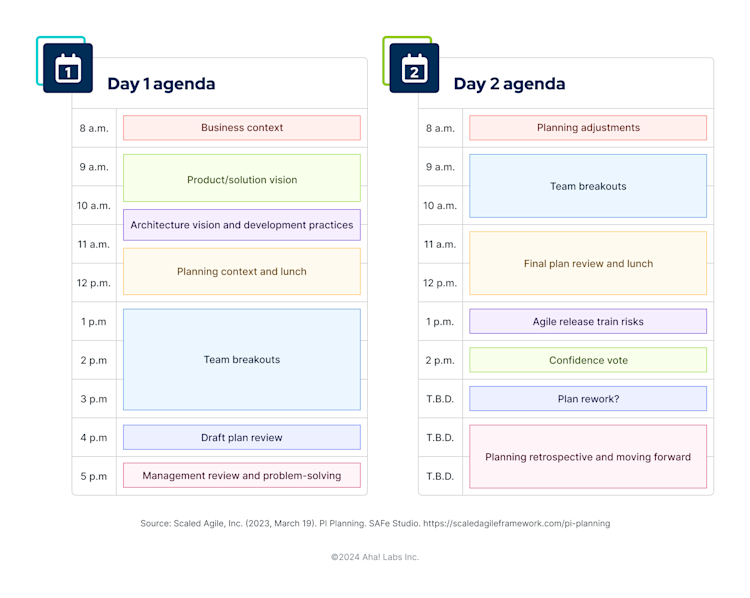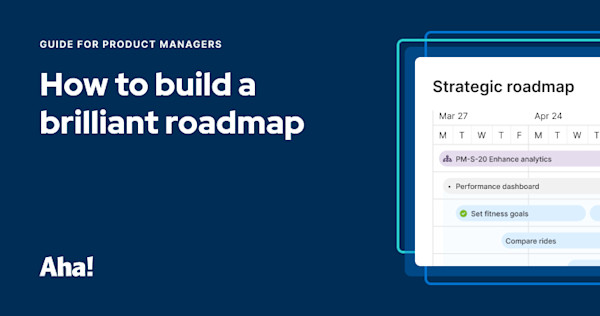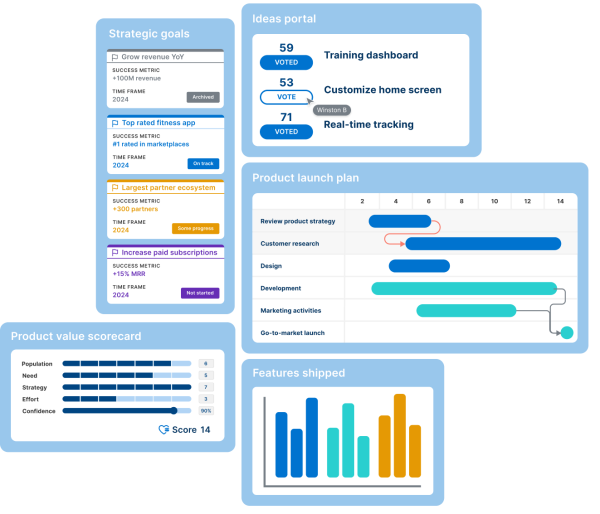PI planning basics: A guide for SAFe® (or SAFe®-ish) product teams
Last updated: February 2025
"Anything is better than PI planning." 🤓 You have probably heard this sentiment from other product managers and engineers (or even posted your own mini rant about it on Reddit). And yet, many of the world's largest and most successful enterprises practice the Scaled Agile Framework® (SAFe®) and its PI planning ceremonies, or some version of them. So, what gives? And is there a way to make PI planning less cumbersome?
PI planning is a structured event for coordinating agile development across multiple teams. It involves set practices, rules, and roles to help teams reach a unified vision and plan for upcoming work. During PI planning, teams often use shared boards, timelines, and templates to visualize work. For some, this can feel like an overly complicated and bureaucratic approach — one that is at odds with the self-organizing, fast-moving agile methodology that many prefer.
It is true that PI planning might be excessive for smaller teams. But large organizations often have several agile teams working on one (or more) products at once. You can imagine how planning months of work across hundreds of engineers could get messy, fast.
Without added layers of structure, people often end up feeling unorganized and misaligned. This is when PI planning can help — even if it is not always a perfect solution. It is designed to alleviate some of this chaos while bringing everyone closer not only to one another, but also to the overall business and product goals.
Streamline PI planning with Aha! software — see how.

Plan your next program increment and run a confidence voting session — all on a whiteboard in Aha! software.
If you are new to SAFe or are joining an organization that does PI planning, you might have some questions (even hesitations) about how it all works. Let's walk through the fundamentals in this guide:
What is PI planning?
PI planning is a recurring event where multiple agile teams and other internal stakeholders come together (remotely or in person) to plan and align on upcoming development work. The event involves estimating work, setting objectives, prioritizing features, and mapping out sprints across teams through a number of structured sessions.
The ultimate goal of PI planning is to agree on a shared vision and plan for the upcoming planning interval (also known as a program increment). You can think of a PI like a mega sprint — it captures up to three months of work to be done across numerous development teams. This work is broken down into individual team sprints (or iterations) within the overall PI.
It can be helpful to learn the inputs and outputs of PI planning (i.e., what is presented at the start vs. what is produced by the end) in order to understand its purpose.
PI planning inputs:
Business context and goals
Prioritized backlog (usually the top 10 features)
PI planning outputs:
PI objectives: Short statements that outline what the participating development teams aim to achieve by the end of the PI
Program board (also known as an ART planning board): A visual tool depicting the new sprint plans, feature delivery dates, milestones, and dependencies among teams
When does PI planning happen?
PI planning typically has a cadence of eight to 12 weeks, and the event itself often takes two full days of live sessions. You can see a sample agenda below.

What types of organizations practice PI planning?
PI planning is part of the SAFe methodology and a required practice for anyone who follows the framework. But these events can be most effective for large enterprise organizations with heightened standards or complexity in the development process. For example:
Companies in industries that must adhere to strict product regulations (such as finance or healthcare technology). A more comprehensive and prescriptive process can reduce risk.
Companies with multidisciplinary products (e.g., software with a hardware component) that might involve manufacturing and supply chain considerations in addition to software development. A standardized approach can bring together these different forms of delivery.
PI planning is also practiced by teams that are not SAFe purists, but do cherry-pick elements to incorporate without committing to the whole framework. You might call this Essential SAFe (or simply being SAFe-ish). It can be helpful for planning near-term agile development work at scale, even if you are not interested in adopting the entire methodology. This is something to keep in mind if SAFe as a whole feels too overbearing.
Our own approach at Aha! incorporates strategic planning sessions and stakeholder syncs that some might consider similar to PI planning. For instance, leaders across the organization get together at fixed planning periods with more flexible work cycles or sprints in between. We call our approach The Aha! Framework.
Related:
Why do organizations carry out PI planning?
A PI plan includes work for many agile teams across several weeks. All of these tasks must be in line with overall business, product, and team goals. Everything also has to fit within the teams' capacity, and engineers must feel confident that they can commit to and complete the plan before moving forward.
That is a lot. So it makes sense that building a PI plan takes serious effort. Organizations host PI planning events to ensure everyone has a recurring and dedicated time to get this done — with the benefit of a structured agenda and set schedule. But there are other reasons why this practice is important. Many businesses see a number of benefits from PI planning, such as the following:
Drives alignments to a shared mission and vision
Encourages a goal-first mindset
Builds relationships across teams and with leadership
Fosters cross-functional collaboration and communication
Builds transparency around priorities and capacity
Helps in adapting to changes and ensuring continuous value delivery
Who is involved in PI planning events?
The unwritten SAFe "rule" is that the people who do the work plan the work. - Scaled Agile Inc.
PI planning is a major cross-functional effort involving everyone from business leadership to product managers and system architects. All of these groups work together to offer various context and direction on the plans.
But at the core of PI planning is the agile release train (ART). In SAFe, an ART is a group of agile teams — it includes all of the scrum masters, product owners, and developers from each team whose work will be defined in the upcoming PI. Because these are the people who will do the work, they play a large part in drafting the overall PI plan.
The table below provides a brief overview of who attends PI planning events and what they contribute:
Role | PI planning responsibilities |
ART |
|
Release train engineer (RTE) |
|
Product managers |
Read more about the role of product managers in SAFe. |
| |
|
Note that if your organization does not have dedicated SAFe roles (such as an RTE), these responsibilities will likely be handled by a project manager or program manager.
How does PI planning work?
What really goes on during PI planning? In brief, participants meet over one or two days to get aligned, draft the PI plan, review it, and commit to it — just like you see in the sample agenda above.
This starts with business and product leaders providing context on current goals and priorities via presentations. From there, agile teams break out to begin drafting the PI's objectives and overall plan, pulling prioritized features into sprints (or iterations) for each group on the program board.
The PI plan goes through multiple rounds of review, and participants make adjustments to accommodate any constraints, dependencies, or critical feedback. The team then holds a confidence vote to ensure there is alignment and support for the plan. Finally, everyone engages in a retrospective to reflect on the planning process. By the end of any PI planning event, everyone involved should be clear on priorities and work to be done for the near future. In short, they are fully prepared to get started and confident that goals can be achieved.
That is a condensed explanation. But it should give you the gist. Remember that your PI objectives and a complete program board are the key outputs to achieve — the number of hours you spend and the exact structure of each session can be adjusted to what is best for your team. For more details, check out the related articles below.
Related:
SAFe® PI planning whiteboard templates
Whether you do PI planning remotely or in person, these events always involve visual components. This helps everyone engage with the in-progress plans and see how everything fits together.
Some teams use PI planning applications, project management software, or Excel to capture their plans. But SAFe is complicated enough as it is — why not make this part a little easier? Although these events involve many stakeholders and decisions, something as simple as an online whiteboard can be a great tool for collaborative PI planning.
If you want to give this a try, we put together a collection of SAFe PI planning whiteboard templates to get you started in Aha! software. It includes these materials:
Program board: Capture PI objectives, backlog, dependencies, and other inputs across sprints.
ROAM board: Identify and categorize risks during PI plan reviews.
Sprint planning: Create a high-level sprint plan for each team within the ART.
PI retrospective: Reflect on what went well and what could be improved for the next PI planning event.
Our built-in fist to five confidence voting tool
Try the PI planning template collection in Aha! software.

In addition to hosting PI planning sessions on whiteboards, you can easily visualize existing roadmaps, reporting views, and even feature records in Aha! software right on the same whiteboard. And once all of your plans are defined, it is simple to start on the tangible work in our agile development tool, Aha! Develop. Give it a try and let us know what you think.
Related:
FAQs about PI planning
What does PI planning stand for?
PI planning stands for "program increment" or "planning interval." (Both terms refer to the same concept.) This is a timebox of work meant for an ART to build and deliver new value. In PI planning, the ART, leadership, and other stakeholders meet to map out what should be completed in the next PI.
PI planning vs. sprint planning — what is the difference?
The primary difference between PI planning and sprint planning is scale. During sprint planning, a single team plans upcoming development work for the next three to four weeks. PI planning has the same general purpose, but involves multiple development teams coordinating work for the next two to three months. Individual teams will conduct sprint planning within the broader PI planning event.
What helps to visualize work during PI planning?
Teams practicing SAFe use a variety of templates and frameworks to visualize work during PI planning events — often with the help of a collaborative visual tool such as an online whiteboard. The most important visual is the program board, which displays the PI objectives and planned work across multiple teams and sprints.


